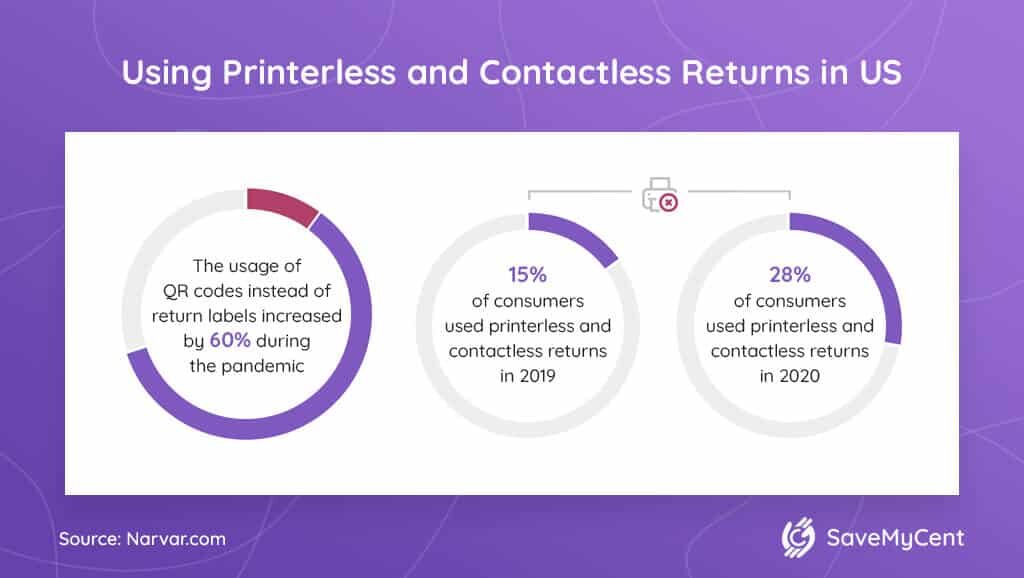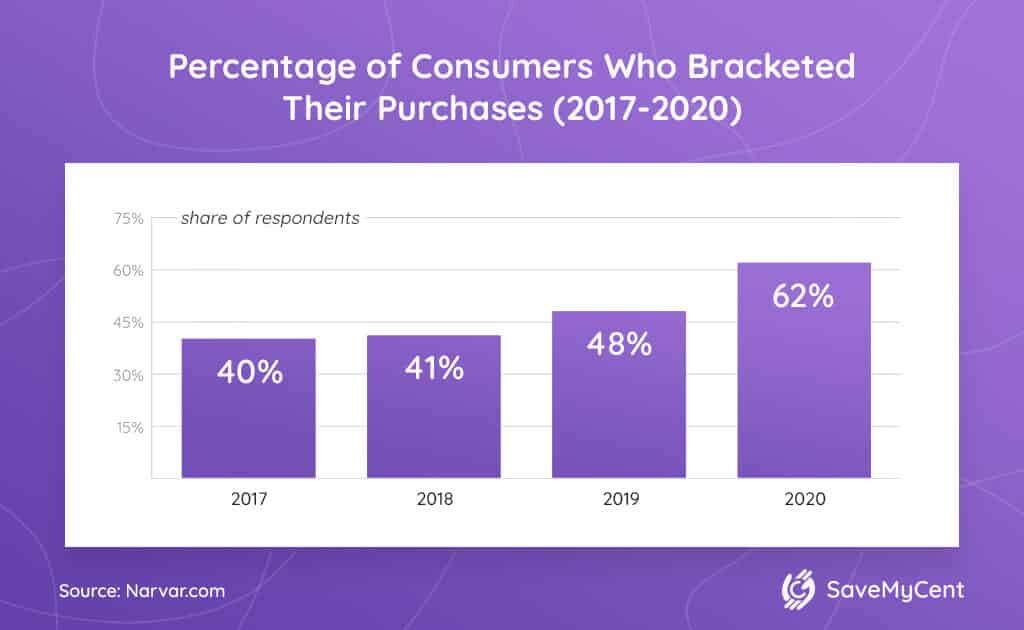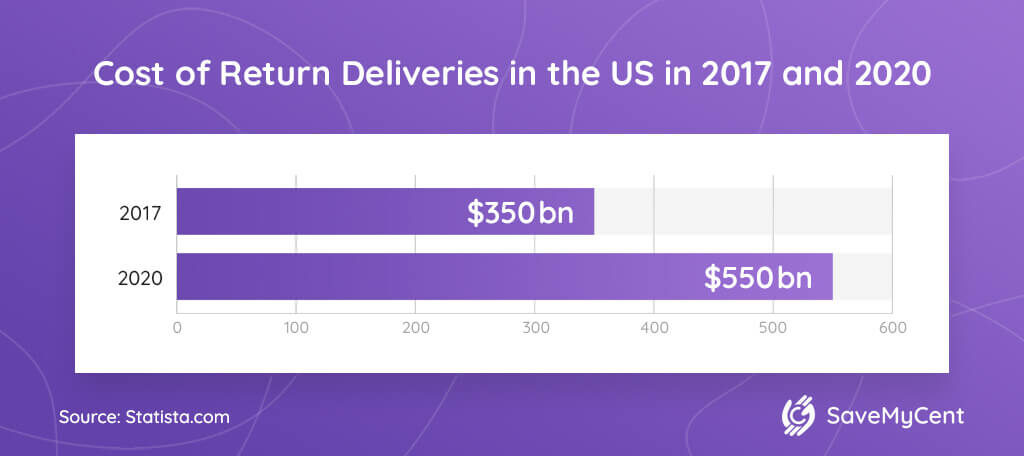Mistakes happen. Sometimes the shoes we’ve bought aren’t that comfy after all, or the jeans don’t fit, even though they looked right online. But the ecommerce industry hasn’t grown this big on ill-fitting jeans.
Ecommerce return rate statistics show that return rates are exceptionally high in ecommerce and that dealing with returns can make or mar one’s business.
However, the companies managed to find creative solutions to this issue, and we can see their progress in the statistics.
So, let’s see how this gigantic industry is dealing with its proportionally huge problem!
Top Ecommerce Return Rate Statistics (Editor’s Choice)
- 48% of online shoppers said they returned an online order in the last 12 months.
- 40% of retailers say they have adjusted their return policies during the COVID-19 pandemic.
- Between 15% and 40% of online purchases end up returned.
- In the US alone, return deliveries were estimated to cost $550 billion in 2020.
- In 2020, 44% of consumers said they were more careful about what they buy so they wouldn’t have to think about returns.
- 73% of shoppers say the overall returns experience affects their likelihood to purchase from a retailer again.
Ecommerce Return Rate Statistics After Covid-19
1. In 2020, 44% of consumers said they were more careful about what they buy so they wouldn’t have to think about returns.
(Narvar)
These 2020 return rate statistics show that consumers take not only the hassle of returns into consideration, but also the environmental and financial impact. They intended to avoid returns so as not to be wasteful when it comes to resources and money.
2. The usage of QR codes instead of return labels increased by 60% during the pandemic, according to Narvar.

28% of consumers used printerless and contactless returns through the course of 2020. This meant improved safety, but also more information on how, why, and when returns took place.
3. In 2020, over 60% of consumers bracketed their purchases.

This is quite an increase compared to 48% in 2019. While some consumers avoid bracketing (buying products, mostly clothes in bulk to try them out and return those that don’t fit), others who used to bracket before the pandemic now do it even more. Also, as many lost or gained weight during the pandemic, they order several sizes to make sure their clothes fit.
Ecommerce Return Rate Stats
4. 10.6% was the overall retail return rate in the US in 2020.
(Statista)
Let’s take a look at the big picture first. According to this report, the percentage of all merchandise returned to stores amounts to one-tenth of all purchases. This has also been the percentage mentioned by the report for the last few years. Retail returns statistics suggest that we should see returns as an unavoidable part of commerce, instead of a minor irregularity.
5. Between 15% and 40% of online purchases end up returned.
(CNBC)
According to David Sobie, the CEO and co-founder of Happy Returns, online retail return rates fall somewhere between these two figures. But the high rate of returns and relatively lenient return policies are considered a natural part of the ecommerce ecosystem.
The decisions of an etailer affect not only a company, but also its customers, other retailers, and shipping companies. So, what does it all look like in 2021?
6. UPS expected 1.9 million of online selling returns after the holiday season in January 2020.
(UPS)
After the holiday shopping frenzy calmed down, etailers and shipping companies still had their hands full with returns. Last year, the UPS saw its returns peak on January 2 with a staggering 1.9 million returns.
Shoppers became more empowered in their returns, and companies gained a better understanding of this part of the shopping process. Unsurprisingly, ecommerce return rate stats following the 2020 holiday season showed a 26% increase in returns compared to the 2019 peak.
7. 73% of shoppers say the overall returns experience affects their likelihood to purchase from a retailer again.
(UPS)
Returns are often the decisive moment when a customer judges a retailer’s attitude towards their business. A quick and painless returns experience can help you retain a customer.
What is even more interesting, the first returns experience is thought to be the most important. If the first returns experience is unsatisfactory, a shopper is less likely to buy at a retailer’s.
However, if a retailer overdelivers during the first returns experience, a buyer usually spends more money at their shop and remains a long-term customer. So, the quality of a return policy directly affects a retailer’s customer return rate.
Cost of Returns for Online Retailers
8. In the US alone, return deliveries were predicted to cost $550 billion in 2020.

It’s difficult to pin a precise number to such losses. The number would have to include workers’ salaries, shipping, logistics, and the value of a product itself. If everything is taken into calculation, the $550 billion figure might be even higher. What’s even more alarming, the figure represents a 75.2% increase compared to just four years prior.
9. The average return represents 30% of the purchase price.
(Total Retail)
The average margin for an online purchase is 10% of the price. What’s more, it usually costs around $15 to return a product. Depending on the price of a product and the applied margin, a retailer sometimes needs to sell more units of the same product to cover the price of one return. Interestingly, the cheaper a product is, the more expensive its return.
10. According to the latest stats, the annual value of merchandise from online shopping returns in the US was estimated to be around $41 billion (2019).
(Appriss Retail)
This number is only a part of the total ecommerce returns value in the US, which the report estimates to be around $309 billion.
As returns cannot always be resold or put back into circulation, around 25% of the merchandise ends up in landfills. That means that a lot of resources, labor, and expenses end up wasted.
This is why we hope that through the future ecommerce return rate statistics, we will get to see better use of resources. Fortunately, this year proves that policies and habits do change.
11. 40% of surveyed retailers say they have adjusted their return policies during the COVID-19 pandemic.
(Statista)
Most large retailers, such as Walmart and Amazon, lengthened their return policies or changed them otherwise. Retailers adjusted the policies to respond to safety requirements and the rising pressure on shipping companies.
Another reason to adjust the return policy is that people now prioritize the convenience of their overall shopping experience. It’s not surprising then that another 27% of retailers were considering making changes to their return policies in 2020.
Ecommerce Return Rate Statistics and Customer Experience
12. 48% of online shoppers said they returned an online transaction in the last 12 months.
(Narvar)
This piece of statistics shows us that the experience of returning a product bought online is a regular occurrence. From the perspective of an online shopper, you will likely have to return something at some point. This is why sensible return policies are of such importance.
13. 42% of shoppers say that for a positive experience in online shopping, free returns are quintessential.
(UPS)
The number of online shoppers is constantly growing, and the activity itself is now far from just an alternative to regular shopping. Customers demand their experience to be taken more seriously and naturally seek the best option. However, the shipping rates make up a large portion of return costs, and retailers can’t sometimes refund such expenses.
14. 49% of shoppers take their time to check the return policy before completing an online transaction.
(Narvar)
The main takeaway from this data on the ecommerce return rate is that a return policy needs to be reasonable, clear, detailed, and easy to find. Covering this is more profitable for a retailer in the long run, as it attracts potential customers.
The same report mentions that online shoppers would appreciate a no-questions-asked return policy. While this is not always an option for a retailer, it illustrates how important it is to respect a customer’s decision to return a product.
15. 40% of shoppers buy multiple items with an intention to return some of them to a retailer.
(Narvar)
This practice of buying with an intention to return some of the items is called bracketing. Online shopping return rate statistics show that high-income shoppers and women are most likely to bracket items.
The gist of the practice is to create a fitting room experience at home. Shoppers buy items in different sizes and colors, and then return those they don’t like. It’s no surprise that retailers most commonly see it happen with apparel, footwear, and home decor products.
Ecommerce Return Rate Statistics by Industry
16. 41.4% of online shoppers are most apprehensive when it comes to buying apparel online.
(Radial)
Lenient and clear return policies encourage online shoppers to complete their purchases. Below, we have provided the list of categories by industry that shows what shoppers are most concerned about:
- Clothing and accessories — 41.4%
- Jewelry and luxury products — 30.7%
- Groceries and household products — 26%
- Electronics — 23.5%
- Health and beauty — 17.9%
- Sports and outdoors equipment — 14.8%
As many shoppers inspect the return policy first, it is of key importance when it comes to these product categories. Let’s see how these concerns correlate with increasing ecommerce return rates.
17. Product return rate analysis shows that apparel still held the record for the highest return rate of 21% in 2020.
(Narvar, Statista)
Before anyone gets surprised, let’s point out that the rate was even higher in 2017, standing at a remarkable 43%! The main issue with clothing and footwear is that it doesn’t look or fit the way it promises online. So, what did the ecommerce companies do?
They found ways to reduce return rates in creative ways. The solutions range from try-out apps assisted by AI (extra points for innovation) to the thorough analysis of return rates statistics in order to get a grasp of returners’ profiles. At times you can witness entire companies stepping in to help and make a profit. And what does that mean? It means that return rate issues can be fixed to (almost) everyone’s convenience!
18. The latest info specifies that the average return rate on electronics is 16%.
(Narvar)
Most consumer electronics are returned due to some form of damage, the lack of functionality, or issues with the installation process. While the return rates for apparel have shrunk in the last couple of years, the consumer electronic industry seems to have a rising issue with return rates. Ecommerce statistics show that the return rates for electronics rose from 12% in 2017 to 16% in 2018, causing worries for the consumer electronics industry.
Key Takeaways
Ecommerce return rate statistics show that the cycle of ecommerce wouldn’t be complete without some returns. However, this is the part where both parties feel the shopping has gone a bit wrong. So, communication is crucial.
Apart from effective communication, retailers need to have a reasonably lenient return policy with free return shipping or in-store returns. They also need to be clear about their return policy and knowledgeable about their customers and their habits. And if a customer returns an item for the first time — it is highly recommended that you put in tremendous effort to make your customer’s returns experience as satisfying as possible.
FAQ
Q: What percentage of purchases are returned?
Unsurprisingly, return rates for online stores are much higher than for brick-and-mortar. David Sobie, the CEO and co-founder of Happy Returns, says that people return between 5% and 10% of their in-store purchases. However, as he says, online purchases return percentage climbs to somewhere between 15% and 40%.
Q: How do you calculate ecommerce return?
To calculate the percentage of merchandise returned over a particular time, divide the number of returned items by the number of sold items. Then multiply the result by 100 to get the percentage of ecommerce returns. For example, a store sells 400 dresses, and its customers return 20. Divide 20 by 400, and you get 0.05. Multiply that by 100, and there you have it — the percentage of returned items would be 5%.
Q: How can ecommerce returns be reduced?
The key to all of the following strategies is to understand that returns are an essential and inevitable part of the ecommerce business. They cannot be avoided — only accepted and reduced. Here are some of the ways to reduce ecommerce returns:
- Have a lenient return policy
- Promote store credit or exchange
- Provide limit free shipping for returns
- Promote in-store returns
- Provide more accurate product descriptions
- Ensure correct orders and safe shipping
Q: What percent of Amazon orders are returned?
Amazon’s return percentage is somewhere between 5% and 15% of all orders.
According to ecommerce return rate statistics, Amazon customers are least likely to return books and media and most likely to return apparel. There’s a simple explanation for that: consumers know what they’re getting with books, but a pair of jeans may look lovely online and still not fit.
Resources:







![How to Get Free Clothes From Shein? [2024 Guide]](https://savemycent.com/wp-content/uploads/2023/09/How-to-Get-Free-Clothes-From-Shein-336x220.png)
